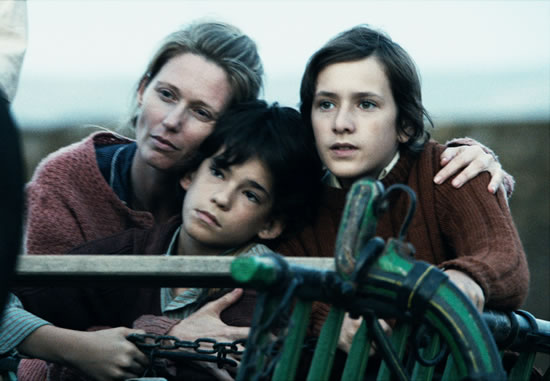MOVIE REVIEW
‘No Place On Earth’: Astonishing New Holocaust Survival Tale
By Jan Aaron

Réka Gavaldi as Leiche Wexler, Norbert Gogan as Leo Wexler and Dániel Hegedus
as Sol Wexler. (Photo courtesy of Magnolia Pictures.)
For educators looking for a new inspiring story when teaching about the Holocaust, a must see movie is Janet Tobias’ “No Place on Earth,” an amazing tale of two Jewish families which survived by living underground.
Chris Nicola, an avid spelunker, was pursuing his interest in a 77-mile long Ukrainian cave in 1993 when he discovered items that had nothing to do with geology – stoves, buttons, and shoes undoubtedly left by 20th century people who had lived there. Intrigued, he began questioning locals for an explanation: “Maybe some Jews lived there,” was all he could find out. No maybe about it!
In fact, nearly 30 members of two families, the Stermers and Wexlers spent 511 days in the cave, in what was then Poland, when World War II broke out. They had planned to immigrate to Canada, but Hitler invaded before their ship could set sail.
Of Eastern European heritage (though not Jewish) Nicola searched for a decade for more information. Eventually, he located a man in the Bronx who, with his extended family, had lived 511 days underground. Others had settled in Montreal. Many never discussed their ordeal, though matriarch Esther Stermer published a memoir about their survival, only 500 copies were printed and most were distributed to Jewish and Holocaust-themed institutions. Through interviews with the remarkable Stermer, Nicola and Tobias have stitched together the history of the 38 people who lived in the cave.
The Tobias’ documentary starts with Nicola’s discovery and ends with 2010 trip back to the cave, during which four survivors were accompanied by two grandchildren. In some segments, actors are used to play the characters and their avengers.
Looking back we learn the two families were well off, and able to buy supplies for their first hiding place, a smaller, more easily accessible cave. Some collected and sold scrap metal to buy food. The most gripping scene occurs when German soldiers show up in their grotto. Marched out to what would be their immediate execution, some were able to slither down darkened passageways, using their knowledge of the labyrinths to vanish. Most survived but were forced to grab a few provisions, and move to a deeper more remote cave. This cave, unlike the first, had an internal water source, but getting food was very difficult, and excursions outside the tunnel were extremely dangerous.
The filmmaker throughout emphasizes the caves’ darkness; she also effectively gives an underground look to survivor stories, by placing her subjects against black background illuminating them with a single spotlight. Among those recounting their ordeal are Sonia and Sima Dodyk, who were little girls when their families moved underground. At the film’s end, we see a 91 year-old survivor watch his granddaughter descend into the cave that saved his life and we are left to ponder on how this riveting story remained a private family tale for sixty years. #
